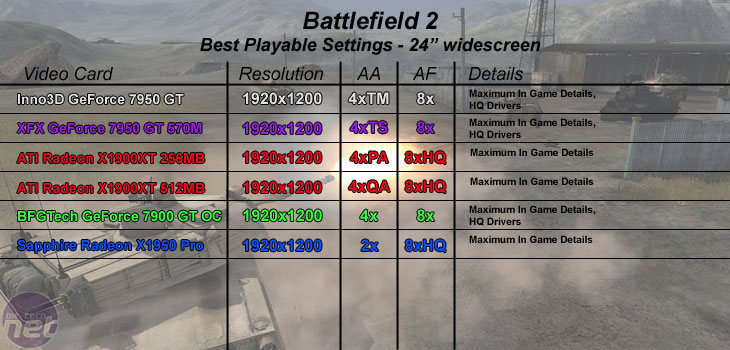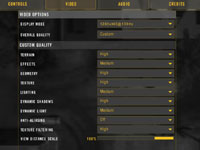24'' Widescreen Gaming:
Battlefield 2
Publisher: Electronic ArtsBattlefield 2 features an all-new game engine based on the DirectX 9.0 API. There is no Shader Model 3.0 support, but the majority of hardware will use a Shader Model 2.0++ mode that includes support for Normal Maps, Parallax Mapping, Full-Resolution Dynamic Shadowing, Post Processing and Fog.
The game will look the same on both NVIDIA and ATI hardware, so there is no advantage of choosing one over the other in image quality related circumstances. The only major difference is that Ultra Shadow 2 is utilised on NVIDIA's hardware, while the shadowing on ATI hardware is done using a slightly different technique.
We patched the game to version 1.4 and then played three five-minute segments of the 'Strike at Karkand' map, reporting the median frame rate. We found that there was no ready way to duplicate testing situations manually in this game, so we felt that taking a typical slice of action from the game was the best way to report our findings. We controlled anti-aliasing from inside the game, while anisotropic filtering was set to 8xAF when the 'Texture Filtering' option was set to 'High'.
________________________________________________________________________________


The XFX GeForce 7950 GT 570M was able to play the game smoothly at the same quality settings, but with transparency supersampling anti-aliasing instead of transparency multisampling. This delivered a more immersive gaming experience overall as the tree leaves, bushes and chain fences were subject to much less aliasing.
ATI’s Radeon X1900XT 512MB delivered a very similar gaming experience, albeit with better texture filtering quality and appreciably less texture shimmering. We were able to achieve smooth gameplay in online scenarios, as well as in our test scenario with 4x quality adaptive anti-aliasing enabled. In order to maintain smooth gameplay on the 256MB variant of the card, we had to lower the adaptive anti-aliasing quality to ‘performance’ – all other quality settings remained the same though.

MSI MPG Velox 100R Chassis Review
October 14 2021 | 15:04









Want to comment? Please log in.